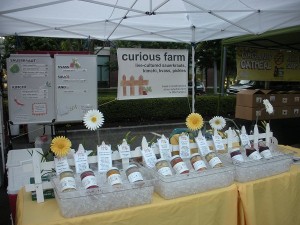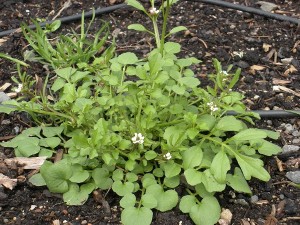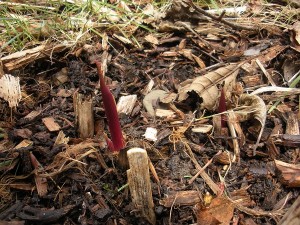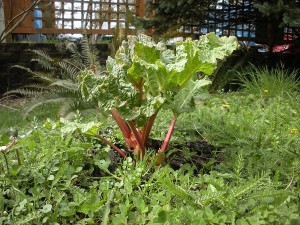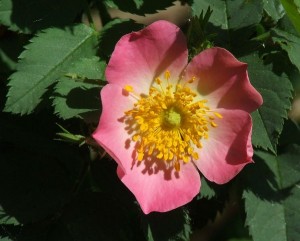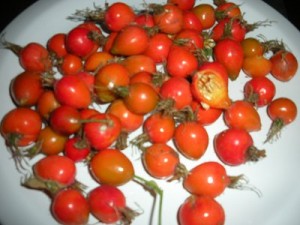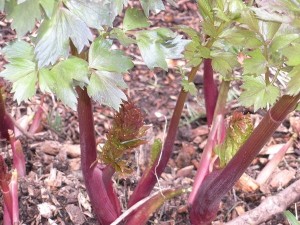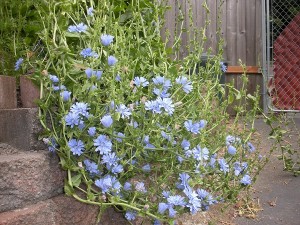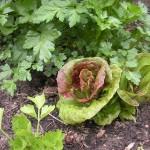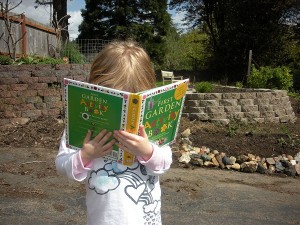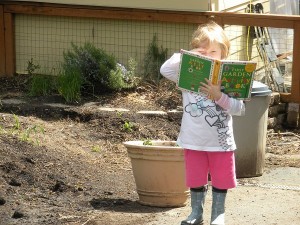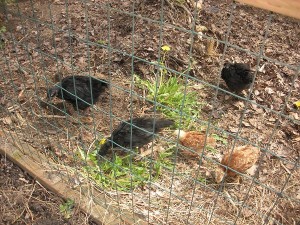
We lost a chicken this evening. We searched all over for a long time. We assume she got taken by a neighbor’s cat or a wild bird. We still don’t have a screen on top of the chicken run, and the chicks were in there most of the day (their choice). We feel sad. I realize that this may happen sometimes, but we’ve invested so much heart into these chicks that it still hurts to lose one.
Also, I hit my knee pretty hard with the shovel. I’m hoping the swelling will go down tomorrow. I had to sink down into the dirt and commune with the worms for awhile (wriggling against my cheek, in fact). No one heard me yell. I couldn’t walk or see for a long time, but I didn’t lose consciousness completely.
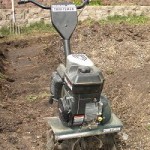 And I shamefully admit that I finally gave up on the double-digging for this year… I feel awful about this, but I couldn’t get my body to dig this morning. There really is some sheet of rock or hardpan down about 18 inches. Every single push with the shovel or fork caused my arm to bounce back. In desperation, I even tried to use the rototiller. No luck. Sadly, I just don’t have the strength or time to break through the rock this year.
And I shamefully admit that I finally gave up on the double-digging for this year… I feel awful about this, but I couldn’t get my body to dig this morning. There really is some sheet of rock or hardpan down about 18 inches. Every single push with the shovel or fork caused my arm to bounce back. In desperation, I even tried to use the rototiller. No luck. Sadly, I just don’t have the strength or time to break through the rock this year.
After rototilling the unfinished half of bed #5, I built up the soil with ammendments and reshaped the bed. Although half of this bed isn’t as deep as all the other double-dug beds, I hope the extra ammendments and raised height will improve the vegetable growth in this spot — which has been problematic in the past, as I have shared.
Here is a photo of the east side of the garden — with 4 1/2 double-dug beds and 1/2 bed that was massacred with a rototiller:
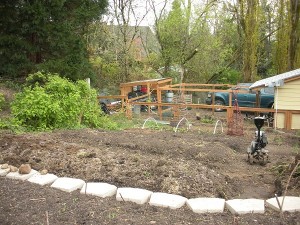
I won’t use the rototiller again. I know it won’t work to break through the rock. I still have to make 4 beds on the west side of the garden:
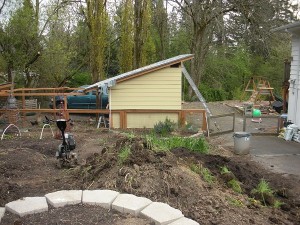
These won’t be as long, but they’ll match up with the beds on the east side in width and placement. I’m going to use a lasagna-method to make these beds so that I can retain more control over how the ammendments get worked into the soil. They will be a lot of work, but I won’t have to dig into hard clay. I’ll use straw on the bottom and build layers with compost, ammendments, and the already-excavated pile of (previously-ammended) top-soil that’s in the foreground of the photo above.
Also in the two pictures above, you can see the coop and run in the background. The chicken run is larger than needed, and we’ll be fixing it up with roosts and a more sheltered area for when it rains. But right now the birds are loving it out there because in the middle of it is an old pile of yard debris.
After the coop is done, we’ll paint it white so that it matches the house, and we’ll modify the shed you can see in the left background of the east part of the garden — to support that shed better and to square up some visual lines.
If you’re wondering about the big mass of green on the east side of the garden, that’s the raspberry patch. We need to add more wire supports there so that they stand more upright. Last year, we had berries all summer — enough for breakfast most days, not enough for jam. I think the plants are robust enough for me to harvest a lot of raspberry leaves this year for medicinal teas. Kids like raspberry leaf tea, and the chickens seem to like eating them, too. Raspberry leaves taste like lemony rose petals (and they’re related to our friend rose, in fact).
Aside from the missing chick (really sad about this), my sore knee, and having to cry uncle about the digging and use a rototiller (ick), I felt really happy to work outside this weekend. I loved watching the chickens mingle. I saw more peas surface. David and I planted a first group of potatoes.
I’ve been trying to get the chickens to wander over here to this sweet spot so that I can get a nice photo, but they’re more interested in the dead leaves in the chicken run. Oh well… I’ll share some of this good spring energy with you anyway!
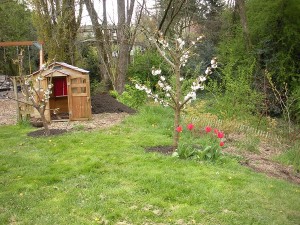
And here is one of my special crabapple trees in bloom and a view down to the seasonal creek (the dark ditch in the middle-left of the photo):
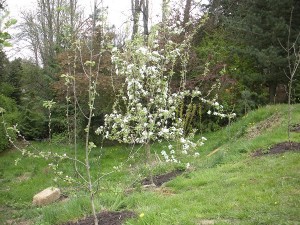
Do you understand why this two-thirds-of-an-acre is so important to us?
We are rich in this spot of dirt and poor in other ways. We are breaking our backs, knees, and hearts to grow or shepherd vitality of all kinds here.
 I’ll be back at the Beaverton Farmers Market on Saturday, June 2nd, with a big smile on my face and some of our new Curious Farm Nettle Sauerkraut — which is packed with savory, satisfying flavor and minerally goodness. Nettles are high in potassium, calcium, chromium, copper, magnesium, and iron. Once cooked (or fermented), they lose their sting — but not their exceptional nutrition. Come try some!
I’ll be back at the Beaverton Farmers Market on Saturday, June 2nd, with a big smile on my face and some of our new Curious Farm Nettle Sauerkraut — which is packed with savory, satisfying flavor and minerally goodness. Nettles are high in potassium, calcium, chromium, copper, magnesium, and iron. Once cooked (or fermented), they lose their sting — but not their exceptional nutrition. Come try some!
